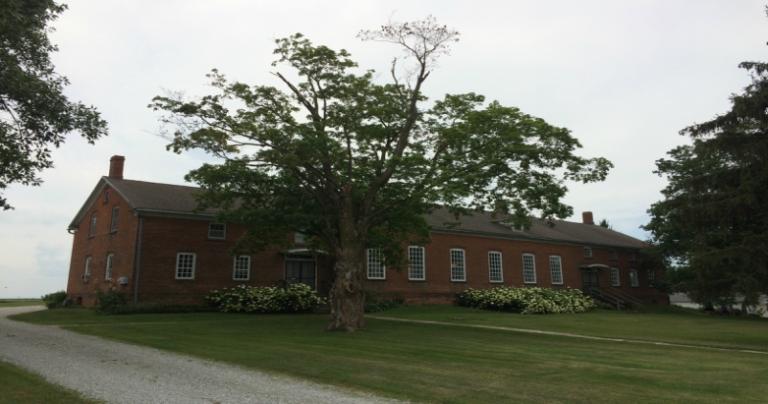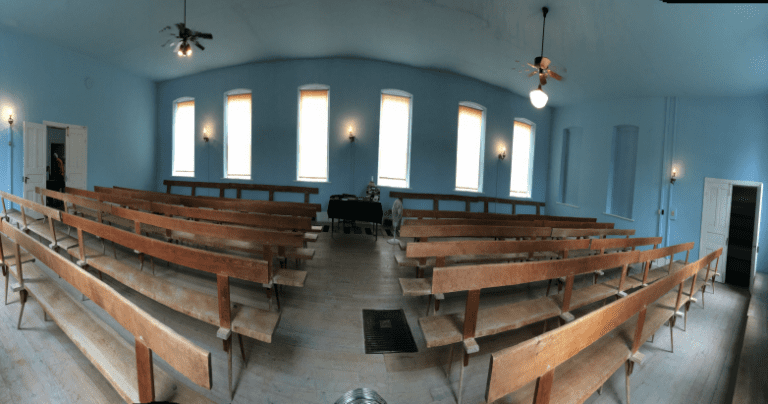“Many of these ideal communities fell short, remembered now only in traces or ruins,” wrote Agnes recently of 19th century America’s many utopian societies. “Religious conviction established some of these. Others tried economic programs, equality of labor and capital, equality of sexes or races.” Earlier this summer I visited one unusually well-preserved ideal community: the Amana Colonies. Amana receives scarcely a mention from any of the three histories mentioned by Agnes, so let me introduce those interested to a society whose egalitarian economic program was — for over two centuries, first in Germany and then New York and Iowa — inseparable from pietistic religious conviction.

The Amana colonies were founded in 1855 by a group of German emigrants (the Community of True Inspiration — more on that title shortly), who left an initial settlement near Buffalo, New York for the rich farmland of Iowa. Split among seven small villages located about 100 miles east of Des Moines, the Amana settlers lived communally. Work, education, and even dining were shared in common. “[T]he communism of Amana is not a dream,” wrote local historian Bertha Shambaugh in 1908, “it is a fact—an established order of life.”
Amana’s “New Spiritual Economy” lasted until 1932, when the Great Depression — and the lingering effects of an explosion that destroyed the community’s uninsured mill — forced the residents to seek outside jobs, recognize private property, and reorganize the Amana Society as a for-profit company. Amana is now a tourist destination, and Whirlpool occupies the nearby refrigeration factory that took its name from the colonies.
I suspect that most visitors are drawn to Amana by the themes that started Shambaugh’s history of the colonies:
A bit of Europe in America, a voice out of the past on the world’s western frontier, this unique Community stands as the nearest approach in our day to the Utopian’s dream of a community of men and women living together in peace, plenty, and happiness, away from the world and its many distractions.
In this sense, I’d guess that the Amana Colonies inspire the same kind of interest as Amish Country. At least, that’s what our seven-year old daughter said: not just the clothing and German language, but the deeper commitments to peace, simplicity, and discipline reminded her of our visit last fall to Amish farms in Lancaster County, Pennsylvania. Like those Anabaptists, the people of the Community of True Inspiration were pacifists who refused to swear oaths. Such religious convictions incurred persecution that helped drive them from Germany to America.
![German sign in Middle Amana dining room: "Time is short, [so] keep one another from sorrow"](https://wp-media.patheos.com/blogs/sites/168/2017/08/German-sign-in-Amana-kitchen.jpg)
Of more significance, however, than the fact of communism at Amana is the deeper truth that, while standing at the head of successful communistic societies, the rise and development of the Community of True Inspiration were in no way inspired by the social philosophy of the eighteenth and nineteenth centuries. Indeed, communism is only incidental to the life and thought of this Community: its chief concern is spiritual. Born of religious enthusiasm and disciplined by persecution, it has ever remained primarily a Church. And so the real Amana is Amana the Church — Amana the Community of True Inspiration.
While the “Great Change” of 1932 reshaped the economy of those villages, the Amana church remained largely intact. Present-day members of that congregation (we heard numbers ranging from 200 to 400) no longer worship the eleven times expected in the heyday of the Community, but the unadorned church in Middle Amana holds two Sunday morning services that function much like they always have — albeit the more popular one is in English, while the early service continues in German. According to our guide at the church museum in Homestead, the service lasts little more than half an hour, is led by seven elders (four men, three women) rather than a pastor, and features prayer, Bible reading (at least in part with individuals trading verses), and a cappella singing.
Again Shambaugh’s observation holds up a century later: “…the Community of True Inspiration is foreign to its surroundings — so much so that the visitor is at once impressed with the fact that here is something different from the surrounding world.”

At least at its origin, that difference is the result of Pietism.
The Community of True Inspiration originated in 1714, where Eberhard Ludwig Gruber (a Lutheran pastor) and Johann Friedrich Rock (a pastor’s son) grew critical of the “utter hollowness and formality” of the state church and began to read the works of Philipp Spener. But they also read from Radical Pietists and earlier mystics, who convinced them that the same God who inspired the Holy Scriptures centuries earlier “will inspire His followers now as then.” Gruber and Rock taught that God endowed certain individuals as “instruments” (Werkzeuge) who received inspirations after meditating on Bible verses. Of the resulting “new word and testimony,” Gruber claimed that “Its truths are in common with the written word of the prophets and apostles,” with the Bible and newer testimonies “after the likeness of two sons and brothers, in which case the oldest son as the first-born has the preference before the younger son who was born after him, though they are both equal and children begotten of one and the same father.”
While the so-called Inspirationists were instructed to “[f]ly from the society of women-kind as much as possible,” inspiration was not limited by sex. The last Werkzeug was a woman named Barbara Heinemann, whose 19th century testimonies are still read in Amana worship to this day.
At least in my limited reading of their history, however, the Inspirationists avoided some of the problems that tend to plague such Christian communities. I don’t know many such sects that regularly recite the Apostles’ Creed, and the community’s religious statements have strikingly little to say about the End Times. While the Community had charismatic leaders, any inspiration was investigated by a committee, which rejected those deemed to be false and required a response of “sincere submission and humiliation.” (Here too, women played a leading role: the first false testimony was condemned by Johanna Melchior in 1715.) Moreover, the “new spiritual economy” placed overwhelming emphasis on humility, obedience, and self-sacrifice. Christian Metz, the Werkzeug who served as the primary leader of the Colonies in New York and Iowa, warned that “self-love and a false desire of the soul” could tempt people to fake testimonies. Indeed, Shambaugh reported that the vast majority of those statements simply admonished hearers “to live a holier life.”

Knowing that there’s been no such testimony since Heinemann died in 1883, I asked our church guide what would happen if a member of the present-day community came forward with a testimony. She thought a moment and said that the elders would have to verify it. But she didn’t expect it to happen again.
“The world is too noisy,” she shrugged. In her opinion, the prevalence of media made it too hard for anyone in 21st century America to meditate deeply on Scripture and hear the voice of God.
An expanded version of this post appeared at The Pietist Schoolman.

















